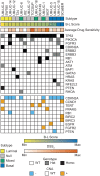MEK is a promising target in the basal subtype of bladder cancer
- PMID: 33216841
- PMCID: PMC7646827
- DOI: 10.18632/oncotarget.27767
MEK is a promising target in the basal subtype of bladder cancer
Abstract
While many resources exist for the drug screening of bladder cancer cell lines in 2D culture, it is widely recognized that screening in 3D culture is more representative of in vivo response. Importantly, signaling changes between 2D and 3D culture can result in changes to drug response. To address the need for 3D drug screening of bladder cancer cell lines, we screened 17 bladder cancer cell lines using a library of 652 investigational small-molecules and 3 clinically relevant drug combinations in 3D cell culture. Our goal was to identify compounds and classes of compounds with efficacy in bladder cancer. Utilizing established genomic and transcriptomic data for these bladder cancer cell lines, we correlated the genomic molecular parameters with drug response, to identify potentially novel groups of tumors that are vulnerable to specific drugs or classes of drugs. Importantly, we demonstrate that MEK inhibitors are a promising targeted therapy for the basal subtype of bladder cancer, and our data indicate that drug screening of 3D cultures provides an important resource for hypothesis generation.
Keywords: 3D culture; MEK inhibition; basal bladder cancer; bladder cancer; drug screen.
Copyright: © 2020 Merrill et al.
Conflict of interest statement
CONFLICTS OF INTEREST Authors have no conflicts of interest to declare.
Figures




Similar articles
-
Transcriptional changes associated with in vivo growth of muscle-invasive bladder cancer cell lines in nude mice.Am J Clin Exp Urol. 2018 Jun 15;6(3):138-148. eCollection 2018. Am J Clin Exp Urol. 2018. PMID: 30038946 Free PMC article.
-
Structure establishment of three-dimensional (3D) cell culture printing model for bladder cancer.PLoS One. 2019 Oct 22;14(10):e0223689. doi: 10.1371/journal.pone.0223689. eCollection 2019. PLoS One. 2019. PMID: 31639124 Free PMC article.
-
Development of 3D culture models of plexiform neurofibroma and initial application for phenotypic characterization and drug screening.Exp Neurol. 2018 Jan;299(Pt B):289-298. doi: 10.1016/j.expneurol.2017.10.012. Epub 2017 Oct 19. Exp Neurol. 2018. PMID: 29055717 Free PMC article.
-
Advances in the bladder cancer research using 3D culture models.Bladder (San Franc). 2023 May 30;10:e21200005. doi: 10.14440/bladder.2023.856. eCollection 2023. Bladder (San Franc). 2023. PMID: 37936584 Free PMC article. Review.
-
Bladder cancer: therapeutic challenges and role of 3D cell culture systems in the screening of novel cancer therapeutics.Cancer Cell Int. 2023 Oct 25;23(1):251. doi: 10.1186/s12935-023-03069-4. Cancer Cell Int. 2023. PMID: 37880676 Free PMC article. Review.
Cited by
-
Bortezomib advanced mechanisms of action in multiple myeloma, solid and liquid tumors along with its novel therapeutic applications.EXCLI J. 2023 Jan 16;22:146-168. doi: 10.17179/excli2022-5653. eCollection 2023. EXCLI J. 2023. PMID: 36998701 Free PMC article. Review.
-
Repurposing Amiodarone for Bladder Cancer Treatment.Cancer Res Commun. 2025 Jun 1;5(6):906-920. doi: 10.1158/2767-9764.CRC-24-0433. Cancer Res Commun. 2025. PMID: 40353763 Free PMC article.
-
Optimizing Precision Medicine for Breast Cancer Brain Metastases with Functional Drug Response Assessment.Cancer Res Commun. 2023 Jun 21;3(6):1093-1103. doi: 10.1158/2767-9764.CRC-22-0492. eCollection 2023 Jun. Cancer Res Commun. 2023. PMID: 37377606 Free PMC article.
-
Spontaneous Necrosis of a High-Risk Bladder Tumor Under Immunotherapy for Concurrent Malignant Melanoma: Role of BRAF Mutations and PD-L1 Expression.Biomedicines. 2025 Feb 5;13(2):377. doi: 10.3390/biomedicines13020377. Biomedicines. 2025. PMID: 40002790 Free PMC article.
-
Growth Hormone Signaling in Bladder Cancer: Transcriptomic Profiling of Patient Samples and In Vitro Evidence of Therapy Resistance via ABC Transporters and EMT Activation.Int J Mol Sci. 2025 Jul 23;26(15):7113. doi: 10.3390/ijms26157113. Int J Mol Sci. 2025. PMID: 40806252 Free PMC article.
References
-
- Damrauer JS, Hoadley KA, Chism DD, Fan C, Tiganelli CJ, Wobker SE, Yeh JJ, Milowsky MI, Iyer G, Parker JS, Kim WY. Intrinsic subtypes of high-grade bladder cancer reflect the hallmarks of breast cancer biology. Proc Natl Acad Sci U S A. 2014; 111:3110–3115. 10.1073/pnas.1318376111. - DOI - PMC - PubMed
-
- Choi W, Porten S, Kim S, Willis D, Plimack ER, Hoffman-Censits J, Roth B, Cheng T, Tran M, Lee IL, Melquist J, Bondaruk J, Majewski T, et al.. Identification of distinct basal and luminal subtypes of muscle-invasive bladder cancer with different sensitivities to frontline chemotherapy. Cancer Cell. 2014; 25:152–165. 10.1016/j.ccr.2014.01.009. - DOI - PMC - PubMed
-
- Rebouissou S, Bernard-Pierrot I, de Reynies A, Lepage ML, Krucker C, Chapeaublanc E, Herault A, Kamoun A, Caillault A, Letouze E, Elarouci N, Neuzillet Y, Denoux Y, et al.. EGFR as a potential therapeutic target for a subset of muscle-invasive bladder cancers presenting a basal-like phenotype. Sci Transl Med. 2014; 6:244ra91. 10.1126/scitranslmed.3008970. - DOI - PubMed
Grants and funding
LinkOut - more resources
Full Text Sources

